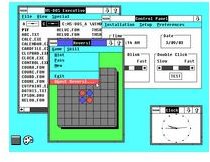This Day in Computer History: October 6
This Day in Computer History
1908
The Ohio Art company was founded by Henry Simon Winzeler. The company later manufactured the Etch-A-Sketch, one of the earliest popular “hand-held gaming devices” in history and the Etch A Sketch Animator 2000, which was among the earliest electronic gaming devices.
1983
Lotus Development, founded by Mitch Kapor and Jonathan Sachs in 1982, goes public after a year resulting in $54 million in sales that left the company the world’s single largest independent software developer. The company’s success was the result of it spreadsheet application, Lotus 1-2-3, which dominated the market by bypassing the IBM PC’s operating system to gain a competitive edge in terms of speed. The company soon after went on trounce its main competitor, Visicalc, the PC’s original “killer app.”
1987
Microsoft introduced Microsoft Windows 2.0 and Microsoft Windows/386 operating systems. Windows 2.0 introduces the notable advance of allowing individual system windows to overlap each other, unlike Windows 1.0, in which windows could only be tiled. The system is also the first to introduce the now-standard terms “Minimize” and “Maximize.” Price: $195
Microsoft introduced the Microsoft Excel spreadsheet application for Microsoft Windows 2.0, to compete with Lotus 1-2-3 and VisiCalc. While, substantively, Excel varies little from its two competitors in terms of performance and capabilities, Excel’s glossy interface will quickly bring it to the forefront of the spreadsheet market. Despite Microsoft’s thriving success, the application is consider to be the company’s first major release, putting Microsoft on the map for business consumers.
1996
Intel released the 200Mhz version of the Pentium Processor.
1997
During an trade conference, Michael Dell, founder of the computer manufacturer Dell, is asked his opinion on the current situation at Apple Computer in which Steve Jobs had been asked to temporarily act as CEO following the ousting of Gil Amelio. Dell replied, “What would I do? I’d shut it down and give the money back to the shareholders.” The reply will go down in history as one of the most notorious forecasts of a company’s prospects in computer in history. By Friday, January 13, 2006, Apple’s US $72.13 billion market cap will have stabilized and surpassed Dell’s US $71.97 billion market cap, and Apple will go on to emerge as one of the industry’s most tradable brands, even as Dell’s rapid expansion of the late nineties levels off.
1998
Apple Computer released two new iMac commercials starring Jeff Goldblum. The thirty-second television spots premiere during Home Improvement on the ABC network.
Intel announced a 450 MHz version of its Pentium II Xeon processors, which were designed for use in dual-processor servers and workstations.
Microsoft released version 6.0 of the Visual J++ Java development platform. Price: $109 (Standard) or $549 (Professional)
1999
It’s announced that the U.S. Justice Department spent over US $12.6 million litigating its antitrust case against the Microsoft Corporation since 1989.
2000
Sony released its new line of Vaio PictureBook laptops in Japan. The computers are the first to feature Transmeta Crusoe processors.
2003
Charter Communications challenged the Recording Industry Association of America’s use of the Online Copyright Infringement Liability Limitation Act, also known as the DMCA takedown provisions, become the first cable internet service provider to take a stand against the wholesale revelation of user’s identities.
This post is part of the series: A Chronology of Computer History for the Month of October: This Day in Computer History
This series provides a daily account of what happened on this day in the history of computing and technology. It discusses developments, breaking news, new releases and global implications that occurred as a result of these ground breaking events.
- This Day in Computer History: October 4
- This Day in Computer History: October 5
- This Day in Computer History: October 6
- This Day in Computer History: October 7
- This Day in Computer History: October 8
- This Day in Computer History: October 9
- This Day in Computer History: October 10
- This Day in Computer History: October 11
- This Day in Computer History: October 12
- This Day in Computer History: October 13
- This Day in Computer History: October 14
- This Day in Computer History: October 15
- This Day in Computer History: October 16
- This Day in Computer History: October 17
- This Day in Computer History: October 18
- This Day in Computer History: October 19
- This Day in Computer History: October 20
- This Day in Computer History: October 21
- This Day in Computer History: October 22
- This Day in Computer History: October 23
- This Day in Computer History: October 24
- This Day in Computer History: October 25
- This Day in Computer History: October 26
- This Day in Computer History: October 27
- This Day in Computer History: October 28
- This Day in Computer History: October 29
- This Day in Computer History: October 30
- This Day in Computer History: October 31
